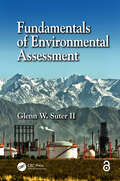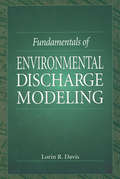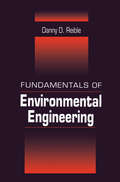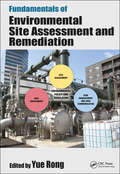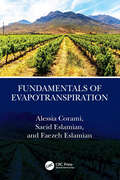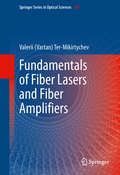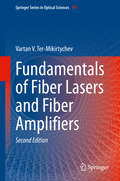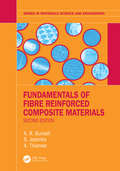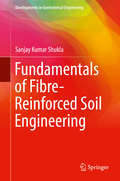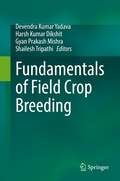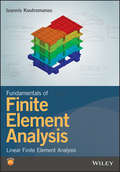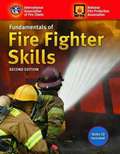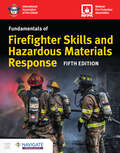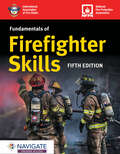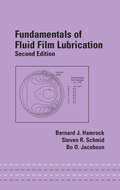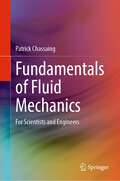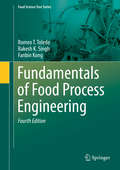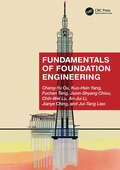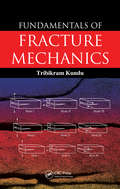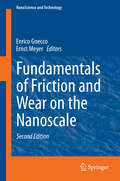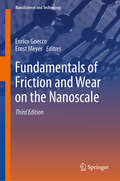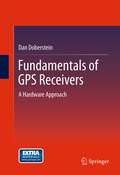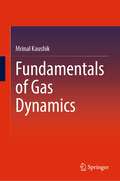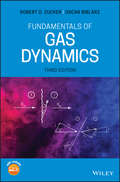- Table View
- List View
Fundamentals of Environmental Assessment
by Glenn W. Suter IIBased on the "go to" book in the field of ecological risk assessment, this shorter, principles-based, updated textbook is essential for students and new practitioners who want to understand the purposes of environmental assessments and how to achieve them. It includes environmental risks to humans as well as nonhuman populations and ecosystems, and most types of environmental assessments. Drawing upon the author’s extensive experience in the field, first as a senior research staff member in the Environmental Sciences Division at Oak Ridge Laboratory and then as science advisor in the United States Environmental Protection Agency’s National Center for Environmental Assessment, the book explains fundamental principles and basic techniques and illustrates them with example applications which carry through multiple chapters and make this book a practical and hands-on guide. Both the content and the style are inviting and approachable to different levels of students.Features Integrates human health and ecological assessments. Includes epidemiological, risk, causal, impact, and outcome assessments. Focuses on fundamental principles that are applicable in all nations and legal contexts. Employs an engaging style and draws on the author’s practical experience. Explains fundamental concepts in short chapters, making it perfect for beginners in the field. Explains the challenges and rewards of a career in environmental assessment. This book is a practical guide for senior and graduate students in environmental sciences and management, as well as new practitioners of assessment who want to understand the purposes of environmental assessments and how to achieve them. The Open Access version of this book, available at www.taylorfrancis.com, has been made available under a Creative Commons Attribution-Non Commercial-No Derivatives (CC-BY-NC-ND) 4.0 license.
Fundamentals of Environmental Discharge Modeling (Mechanical and Aerospace Engineering Series #10)
by Lorin R. DavisThis book examines engineering and mathematical models for documenting and approving mechanical and environmental discharges. The author emphasizes engineering design considerations as well as applications to waste water and atmospheric discharges.Chapters discuss:the fundamentals of turbulent jet mixing, dilution concepts, and mixing zone conceptsdiffuser configurations and head loss calculationsdifferent modeling techniques and accepted models - discussed in detail with theoretical background, restrictions, input, output, and examplesLagrangian and the EPA UM 2-dimensional diffuser modelthe PLUMES interfaceEulerian integral methods, EPA UDKHG 3-dimensional diffuser model, and PDSG surface discharge modelempirical techniques, RSB diffuser model, the CORMIX family of models for both diffusers and surface dischargenumerical methods with a discussion of shelf commercial modelsGaussian atmospheric plume modelsFundamentals of Environmental Discharge Modeling includes numerous case studies and examples for each model and problem.
Fundamentals of Environmental Engineering
by Danny ReibleThe field of environmental engineering is rapidly emerging into a mainstream engineering discipline. For a long time, environmental engineering has suffered from the lack of a well-defined identity. At times, the problems faced by environmental engineers require knowledge in many engineering fields, including chemical, civil, sanitary, and mechanical engineering. Increased demand for undergraduate training in environmental engineering has led to growth in the number of undergraduate programs offered. Fundamentals of Environmental Engineering provides an introductory approach that focuses on the basics of this growing field.This informative reference provides an introduction to environmental pollutants, basic engineering principles, dimensional analysis, physical chemistry, mass, and energy and component balances. It also explains the applications of these ideas to the understanding of key problems in air, water, and soil pollution.
Fundamentals of Environmental Site Assessment and Remediation
by Yue RongFundamentals of Environmental Site Assessment and Remediation examines all aspects of environmental site assessment and remediation and outlines the interdisciplinary skills needed to work in the field. It provides a comprehensive overview for students, environmental professionals, and real estate developers, and includes the latest environmental regulations, environmental site assessment and remediation practices, and industry standards. It examines pollution sources and the related impacts on drinking water supplies, the associated health risks, and how to protect water resources. The monitoring of surface water, groundwater, and soil is explained, as well as vapor intrusion. It will include several practical case studies throughout. Features Includes the latest and best practices for environmental site assessment and remediation procedures. Presents a multidisciplinary approach, including environmental forensics, nanotechnology, microbiology (DNA technology) and isotopes, etc. Examines various pollutants and their related impacts on drinking water supplies, the associated health risks, and how to protect water resources. Presents the best practices for the monitoring of surface water, groundwater, and soil. Covers the latest environmental regulations and industry standards.
Fundamentals of Evapotranspiration
by Saeid Eslamian Faezeh A. Eslamian Alessia CoramiFundamentals of Evapotranspiration aims to determine simple methods to evaluate evapotranspiration and to examine the evolution of these methods over time. It compares and contrasts best practices and discusses the opportunities for harmonization among various methods. Further, the book discusses optimal calibration of these methods in a local context, depending on particular climates and scenarios. The book serves as a practical resource for students and professionals working in agriculture, irrigation and water engineering and will aid in evaluating the methods and equations for the most efficient means of evapotranspiration. The authors examine the methods for evaluating evapotranspiration considering the evaporation from water surfaces, soil and vegetation. The authors address issues according to various regions, climates and soil types, and apply the optimal solution for each situation.
Fundamentals of Fiber Lasers and Fiber Amplifiers
by Valerii Vartan Ter-MikirtychevThis book covers the fundamental aspects of fiber lasers and fiber amplifiers, and includes a wide range of material from laser physics fundamentals to state-of-the-art topics, as well as industrial applications in the rapidly growing field of quantum electronics. Emphasis is placed on the nonlinear processes taking place in fiber lasers and amplifiers, their similarities, differences to, and their advantages over other solid-state lasers. The reader will learn basic principles of solid-state physics and optical spectroscopy of laser active centers in fibers, main operational laser regimes, and practical recommendations and suggestions on fiber laser research, laser applications, and laser product development. The book will be useful for students, researchers, and professionals who work with lasers, in the optical communications, chemical and biological industries.
Fundamentals of Fiber Lasers and Fiber Amplifiers (Springer Series in Optical Sciences #181)
by Vartan V. Ter-MikirtychevThis book covers the fundamental aspects of fiber lasers and fiber amplifiers, and includes a wide range of material from laser physics fundamentals to state-of-the-art topics in this rapidly growing field of quantum electronics. This expanded and updated new edition includes substantial new material on nonlinear frequency conversion and Raman fiber lasers and amplifiers, as well as an expanded list of references inclusive of the recent literature in the field. Emphasis is placed on the nonlinear processes taking place in fiber lasers and amplifiers, their similarities, differences to, and their advantages over other solid-state lasers. The reader will learn the basic principles of solid-state physics and optical spectroscopy of laser active centers in fibers, the main operational laser regimes, and will receive practical recommendations and suggestions on fiber laser research, laser applications, and laser product development. The book will be useful for students, researchers, and professional physicists and engineers who work with lasers in the optical and telecommunications field, as well as those in the chemical and biological industries.
Fundamentals of Fibre Reinforced Composite Materials (Series in Materials Science and Engineering)
by A.R. Bunsell S. Joannès A. ThionnetFibre reinforced composite materials are showing sustained growth in an ever widening range of applications from food trays to spacecraft as well as contributing to resolving environmental problems, including enabling the forthcoming hydrogen economy to be realised. This second edition of Fundamentals of Fibre Reinforced Composite Materials has been fully updated throughout, providing an authoritative and modern introduction to the topic with a brief history of composite development, a review of composite applications, manufacture and markets, types of fibres and matrices used, and their properties with a detailed introduction into the computer simulation of composite behaviour. With extensive sets of sample problems accompanying each chapter, this book is ideally suited to undergraduate and graduate students of materials science, structural, mechanical, and aeronautical engineering, polymer science, metallurgy, and other courses. It will also be of use as a reference to researchers and engineers working with composite materials and material scientists in general. Features: Presents thorough discussions on composite history, composite applications and markets, types of fibres and resins used, and their respective properties Relates mathematical concepts to the structure of the material under discussion leading to the quantitative evaluation of safety factors Provides numerous sets of sample problems in each chapter
Fundamentals of Fibre-Reinforced Soil Engineering
by Sanjay Kumar ShuklaThis book is intended to serve as a one-stop reference on fibre-reinforced soils. Over the past 30-35 years, the engineering behaviour of randomly distributed/oriented fibre-reinforced soil, also called simply fibre-reinforced soil, has been investigated in detail by researchers and engineers worldwide. Waste fibres (plastic waste fibres, old tyre fibres, etc. ) create disposal and environmental problems. Utilization of such fibres in construction can help resolve these concerns. Research studies and some field applications have shown that the fibres can be utilized in large quantities in geotechnical and civil engineering applications in a cost-effective and environmentally friendly manner. This book covers a complete description of fibres, their effects when included within a soil or other similar materials such as the fly ash, and their field applications. It gives a detailed view of fibre-reinforced soil engineering. The book will be useful to students, professional, and researchers alike, and can also serve as a text for graduate coursework and professional development programs
Fundamentals of Field Crop Breeding
by Harsh Kumar Dikshit Gyan Prakash Mishra Devendra Kumar Yadava Shailesh TripathiThis book is an advanced textbook and a reference book for the post-graduate plant-breeding students and the plant breeders. It consolidates fundamental concepts and also the latest advances in plant-breeding practices including development in crop genomics. It contains crop wise explanation on origin, reproduction, genetics of yield contributing traits, biotic and abiotic stresses, nutritional improvement and crop specific plant-breeding procedures and techniques. The chapters are planned to describe crop-focused breeding procedure for the major crop plants as per their economic importance. The recent developments in breeding of field crops have been reported. The recent progress made in mapping traits of economic importance has been critically reviewed for each crop. The progress made in markers assisted selected in few crops has been summarized. This book bridges the knowledge gap and bring to the researchers and students information on modern breeding tools for developing biotic and abiotic stress tolerant, climate resilient and micronutrient rich varieties of field crops. The chapters in book are contributed by experienced Plant Breeders.
Fundamentals of Finite Element Analysis: Linear Finite Element Analysis
by Ioannis KoutromanosAn introductory textbook covering the fundamentals of linear finite element analysis (FEA) This book constitutes the first volume in a two-volume set that introduces readers to the theoretical foundations and the implementation of the finite element method (FEM). The first volume focuses on the use of the method for linear problems. A general procedure is presented for the finite element analysis (FEA) of a physical problem, where the goal is to specify the values of a field function. First, the strong form of the problem (governing differential equations and boundary conditions) is formulated. Subsequently, a weak form of the governing equations is established. Finally, a finite element approximation is introduced, transforming the weak form into a system of equations where the only unknowns are nodal values of the field function. The procedure is applied to one-dimensional elasticity and heat conduction, multi-dimensional steady-state scalar field problems (heat conduction, chemical diffusion, flow in porous media), multi-dimensional elasticity and structural mechanics (beams/shells), as well as time-dependent (dynamic) scalar field problems, elastodynamics and structural dynamics. Important concepts for finite element computations, such as isoparametric elements for multi-dimensional analysis and Gaussian quadrature for numerical evaluation of integrals, are presented and explained. Practical aspects of FEA and advanced topics, such as reduced integration procedures, mixed finite elements and verification and validation of the FEM are also discussed. Provides detailed derivations of finite element equations for a variety of problems. Incorporates quantitative examples on one-dimensional and multi-dimensional FEA. Provides an overview of multi-dimensional linear elasticity (definition of stress and strain tensors, coordinate transformation rules, stress-strain relation and material symmetry) before presenting the pertinent FEA procedures. Discusses practical and advanced aspects of FEA, such as treatment of constraints, locking, reduced integration, hourglass control, and multi-field (mixed) formulations. Includes chapters on transient (step-by-step) solution schemes for time-dependent scalar field problems and elastodynamics/structural dynamics. Contains a chapter dedicated to verification and validation for the FEM and another chapter dedicated to solution of linear systems of equations and to introductory notions of parallel computing. Includes appendices with a review of matrix algebra and overview of matrix analysis of discrete systems. Accompanied by a website hosting an open-source finite element program for linear elasticity and heat conduction, together with a user tutorial. Fundamentals of Finite Element Analysis: Linear Finite Element Analysis is an ideal text for undergraduate and graduate students in civil, aerospace and mechanical engineering, finite element software vendors, as well as practicing engineers and anybody with an interest in linear finite element analysis.
Fundamentals of Fire Fighter Skills (Second Edition)
by National Fire Protection Association Staff International Association of Fire Chiefs StaffLearn more of the fundamental skills necessary to be a successful fire fighter.
Fundamentals of Firefighter Skills and Hazardous Materials Response Includes Navigate Premier Access
by IafcFundamentals of Firefighter Skills with Hazardous Materials Response, Fifth Edition with Navigate Premier Access is the complete teaching and learning solution for Firefighter I and Firefighter II with Hazardous Materials Response courses.
Fundamentals of Firefighter Skills with Navigate Premier Access
by IafcFundamentals of Firefighter Skills, Fifth Edition with Navigate Premier Access is the complete teaching and learning solution for Firefighter I and Firefighter II courses.
Fundamentals of Fluid Film Lubrication (Mechanical Engineering Ser. #Vol. 171)
by Steven R. Schmid Bernard J. Hamrock Bo O. JacobsonSpecifically focusing on fluid film, hydrodynamic, and elastohydrodynamic lubrication, this edition studies the most important principles of fluid film lubrication for the correct design of bearings, gears, and rolling operations, and for the prevention of friction and wear in engineering designs. It explains various theories, procedures, and equations for improved solutions to machining challenges. Providing more than 1120 display equations and an introductory section in each chapter, Fundamentals of Fluid Film Lubrication, Second Edition facilitates the analysis of any machine element that uses fluid film lubrication and strengthens understanding of critical design concepts.
Fundamentals of Fluid Mechanics: For Scientists and Engineers
by Patrick ChassaingThis textbook provides a coherent and structured overview of fluid mechanics, a discipline concerned with many natural phenomena and at the very heart of the most diversified industrial applications and human activities. The balance between phenomenological analysis, physical conceptualization and mathematical formulation serve both as a unifying educational marker and as a methodological guide to the three parts of the work. The thermo-mechanical motion equations of a homogeneous single-phase fluid are established, from which flow models (perfect fluid, viscous) and motion classes (isovolume, barotropic, irrotational, etc.) are derived. Incompressible, potential flows and compressible flows, both in an isentropic evolution and shock, of an ideal inviscid fluid are addressed in the second part. The viscous fluid is the subject of the last one, with the creeping motion regime and the laminar, dynamic and thermal boundary layer. Historical perspectives are included whenever they enrich the understanding of modern concepts. Many examples, chosen for their pedagogical relevance, are dealt with in exercises.The book is intended as a teaching tool for undergraduate students, wishing to acquire a first command of fluid mechanics, as well as graduates in advanced courses and engineers in other fields, concerned with completing what is sometimes a scattered body of knowledge.
Fundamentals of Fluid Power Control
by John WattonThis exciting new reference text is concerned with fluid power control. It is an ideal reference for the practicing engineer and a textbook for advanced courses in fluid power control. In applications in which large forces and/or torques are required, often with a fast response time, oil-hydraulic control systems are essential. They excel in environmentally difficult applications because the drive part can be designed with no electrical components and they almost always have a more competitive power/weight ratio compared to electrically actuated systems. Fluid power systems have the capability to control several parameters, such as pressure, speed, position, and so on, to a high degree of accuracy at high power levels. In practice there are many exciting challenges facing the fluid power engineer, who now must preferably have a broad skill set.
Fundamentals of Food Process Engineering (Food Science Text Series)
by Romeo T. Toledo Rakesh K. Singh Fanbin KongWritten for the upper level undergraduate, this updated book is also a solid reference for the graduate food engineering student and professional. This edition features the addition of sections on freezing, pumps, the use of chemical reaction kinetic date for thermal process optimization, and vacuum belt drying. New sections on accurate temperature measurements, microbiological inactivation curves, inactivation of microorganisms and enzymes, pasteurization, and entrainment are included, as are non-linear curve fitting and processes dependent on fluid film thickness. Other sections have been expanded.
Fundamentals of Foundation Engineering
by Chang-Yu Ou Jianye Ching Kuo-Hsin Yang Fuchen Teng Jiunn-Shyang Chiou Chih-Wei Lu An-Jui Li Jui-Tang LiaoThis book aims to introduce the principle and design of various foundations, covering shallow foundations, mat foundations, earth retaining structures, excavations, pile foundations, and slope stability. Since the analysis and design of a foundation are based on the soil properties under short-term (undrained) or long-term (drained) conditions, the assessment of soil properties from the geotechnical site investigation and the concept of drained or undrained soil properties are discussed in the first two chapters. Foundation elements transfer various load combinations from the superstructure to the underlying soils or rocks. The load transfer mechanisms, vertical stress or earth pressure distributions, and failure modes of each foundation type are clearly explained in this book. After understanding the soil responses subjected to the loadings from the foundation, the design methods, required factors of safety, and improvement measures for each foundation type are elaborated. This book presents both theoretical explication and practical applications for readers to easily comprehend the theoretical background, design methods, and practical applications and considerations. Each chapter provides relevant exercise examples and a problem set for self-practice. The analysis methods introduced in the book can be applied in actual analysis and design as they contain the most up-to-date knowledge of foundation design. This book is suitable for teachers and students to use in foundation engineering courses and engineers who are engaged in foundation design to create a technically sound, construction-feasible, and economical design of the foundation system.
Fundamentals of Fracture Mechanics
by Tribikram KunduAlmost all books available on fracture mechanics cover the majority of topics presented in this book, and often much, much more. While great as references, this makes teaching from them more difficult because the materials are not typically presented in the order that most professors cover them in their lectures and more than half the information p
Fundamentals of Friction and Wear on the Nanoscale
by Enrico Gnecco Ernst MeyerThis book provides an updated review on the development of scanning probe microscopy and related techniques, and the availability of computational techniques not even imaginable a few decades ago. The 36 chapters cover instrumental aspects, theoretical models and selected experimental results, thus offering a broad panoramic view on fundamental issues in nanotribology which are currently being investigated. Compared to the first edition, several topics have been added, including triboluminescence, graphene mechanics, friction and wear in liquid environments, capillary condensation, and multiscale friction modeling. Particular care has been taken to avoid overlaps and guarantee the independence of the chapters. In this way, our book aims to become a key reference on this subject for the next five to ten years to come.
Fundamentals of Friction and Wear on the Nanoscale (NanoScience and Technology)
by Enrico Gnecco Ernst MeyerThis book offers a comprehensive review on the latest developments in the field of nanotribology. With contributed chapters covering instrumental aspects, theoretical models, and selected experimental results, this book provides a broad overview of the fundamental issues currently being investigated in the field. The updated third edition includes new topics such as molecular tribology, multiscale structural lubricity, tribofilm growth, nanoscale friction in liquids, and nanotribology at insect-plant interfaces. Written by a highly qualified group of international experts, this book aims to be a key reference on the subject for the next five to ten years, highlighting the importance of understanding the atomistic origins of friction and wear in everyday life and in technical applications.
Fundamentals of GPS Receivers
by Dan DobersteinFundamentals of GPS receivers covers GPS receivers' theory and practice. The book begins with the basics of GPS receivers and moves onward to more advanced material. The book examines three types of GPS receiver implementations: first is the custom design by the author; second is an industry standard design, now part of the open source network; the third relates to the receiver designed by JPL /NASA. Each receiver is unique allowing the reader to see how each design solves the same problems. Chapters discuss carrier phase measurements and GPS time and frequency measurements. The overall text is measurement oriented as opposed to processing the measurements. With a focus on the fundamentals of measurements the reader will be building their intuition for the physical phenomenon at work.
Fundamentals of Gas Dynamics
by Mrinal KaushikThis textbook for courses in gas dynamics will be of interest to students and teachers in aerospace and mechanical engineering disciplines. It provides an in-depth explanation of compressible flows and ties together various concepts to build an understanding of the fundamentals of gas dynamics. The book is written in an easy to understand manner, with pedagogical aids such as chapter overviews, summaries, and descriptive and objective questions to help students evaluate their progress. The book contains example problems as well as end-of-chapter exercises. Detailed bibliographies are included at the end of each chapter to provide students with further resources. The book can be used as a core text in engineering coursework and also in professional development courses.
Fundamentals of Gas Dynamics
by Oscar Biblarz Robert D. ZuckerNew edition of the popular textbook, comprehensively updated throughout and now includes a new dedicated website for gas dynamic calculations The thoroughly revised and updated third edition of Fundamentals of Gas Dynamics maintains the focus on gas flows below hypersonic. This targeted approach provides a cohesive and rigorous examination of most practical engineering problems in this gas dynamics flow regime. The conventional one-dimensional flow approach together with the role of temperature-entropy diagrams are highlighted throughout. The authors—noted experts in the field—include a modern computational aid, illustrative charts and tables, and myriad examples of varying degrees of difficulty to aid in the understanding of the material presented. The updated edition of Fundamentals of Gas Dynamics includes new sections on the shock tube, the aerospike nozzle, and the gas dynamic laser. The book contains all equations, tables, and charts necessary to work the problems and exercises in each chapter. This book’s accessible but rigorous style: Offers a comprehensively updated edition that includes new problems and examples Covers fundamentals of gas flows targeting those below hypersonic Presents the one-dimensional flow approach and highlights the role of temperature-entropy diagrams Contains new sections that examine the shock tube, the aerospike nozzle, the gas dynamic laser, and an expanded coverage of rocket propulsion Explores applications of gas dynamics to aircraft and rocket engines Includes behavioral objectives, summaries, and check tests to aid with learning Written for students in mechanical and aerospace engineering and professionals and researchers in the field, the third edition of Fundamentals of Gas Dynamics has been updated to include recent developments in the field and retains all its learning aids.
